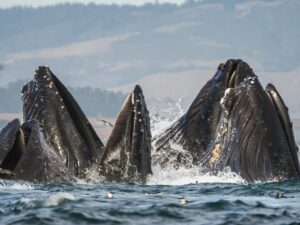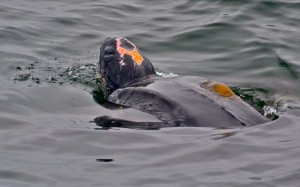On August 10, 2007, the California Coastal Commission unanimously voted to deny a fishing permit to allow experimental long-line fishing off the coast of California and Oregon for the first time since 2004. The proposal by the National Marine Fisheries Service (NMFS) would have allowed the Ocean Pacific Sea Food Company to make four expeditions to test the economic and environmental feasibility of catching swordfish using the long-line method, in which hundreds or thousands of hooks are suspended from a central line as long as 100 kilometers.
In its denial, the Coastal Commission cited concerns that the tests might have serious consequences for a number of protected species, including the critically endangered leatherback turtle.
Like other industrial fishing methods, long-lining can result in a great deal of bycatch, hooking many nontarget species over a wide area. When fishers pursue species such as swordfish, the hooks are rigged to hang at depths of less than 100 meters, which makes them tempting targets for surface-dwellers like marine turtles. Other fishing techniques, such as drift gill netting (in which vertical nets are set and periodically reeled in) and trawling (in which a net is hauled behind a boat or boats) are seasonally permitted in the region affected by the proposed permit. The NMFS suggested that a long-line test—using special “circle hooks” to reduce turtle mortality—might shed light on the relative environmental impacts of those techniques on species like the leatherback.
Weighing in at up to 2,000 pounds, leatherbacks are the largest living reptiles, and they were first listed as endangered in 1970. Their population has declined precipitously since then. A 1982 study by renowned turtle biologist Peter Pritchard estimated that approximately 115,000 mature female leatherbacks existed in the wild, with roughly half of them nesting along the western coast of Mexico. A 2002 population census found fewer than 2,000 mature females along the Pacific coast of the Americas. It is estimated that the Pacific leatherback population is decreasing by as much as a third every year.
Researchers place most of the responsibility for this continued decline on bycatch from industrial fishing. Long-line fishing is not solely to blame: an article published in February 2007 in the journal Conservation Biology suggested that bycatch from the trawl and gillnet fisheries is as high as or higher than that from long-lining, and with significantly higher mortality rates. Furthermore, the NMFS has stated that “[l]ong line fishing is clearly preferable to drift gill when it comes to [bycatch of] marine mammals.” In light of these facts, a reevaluation of permitted Pacific fishery practices might seem welcome, but the Coastal Commission decided that an expansion of fishing in the important foraging waters north of the leatherback’s breeding grounds posed too much of a risk.
The commission did signal that it might be receptive to future experiments to determine what type of Pacific fishery would be least environmentally harmful. The statement denying the long-lining permit notes that conducting a long-line test “in the same waters and period drift gill netting is allowed would appear to provide more useful comparisons of the two fisheries.”
Learn more from this excellent survey of commercial fishing methods.

.jpg)


-300x224.jpg)
-300x234.jpg)